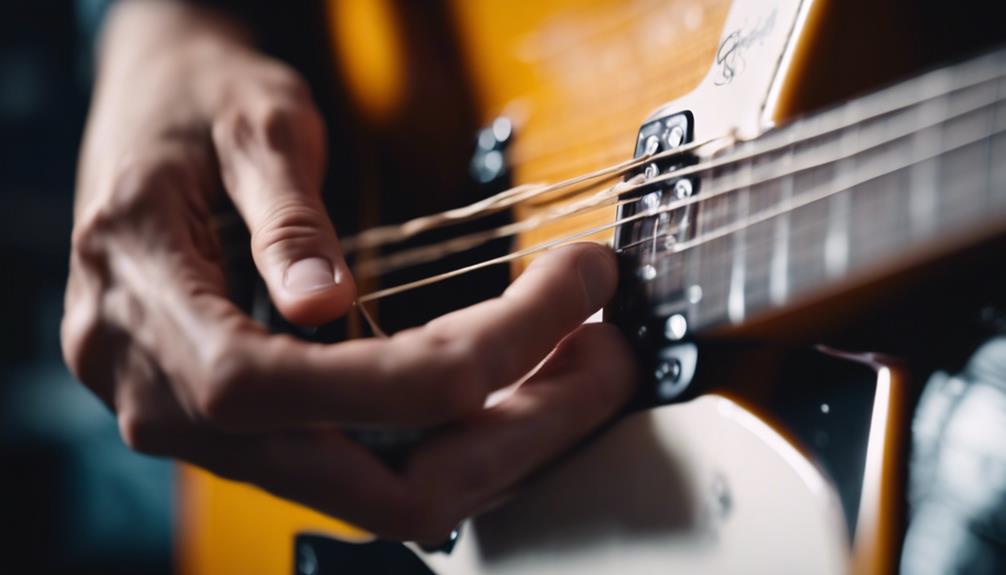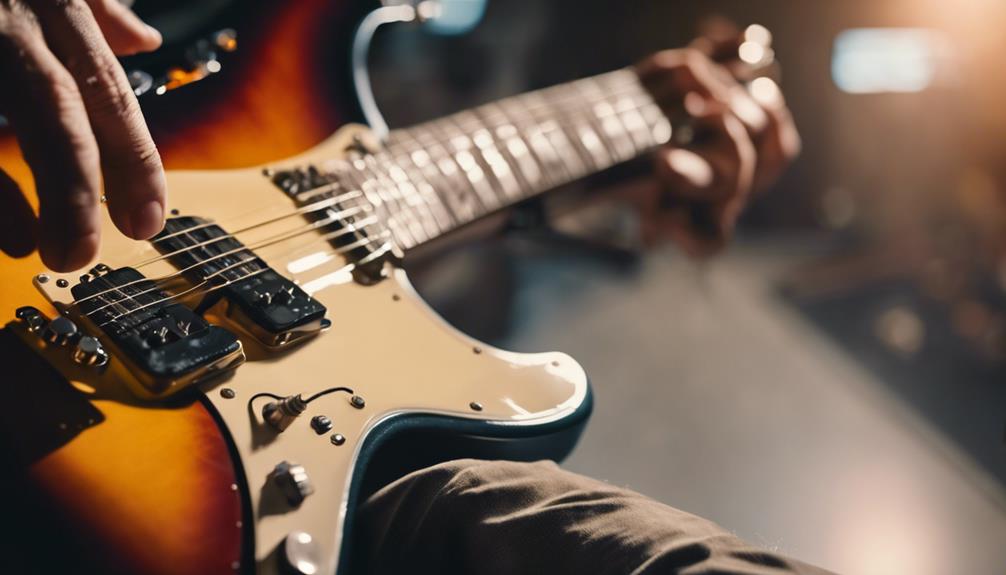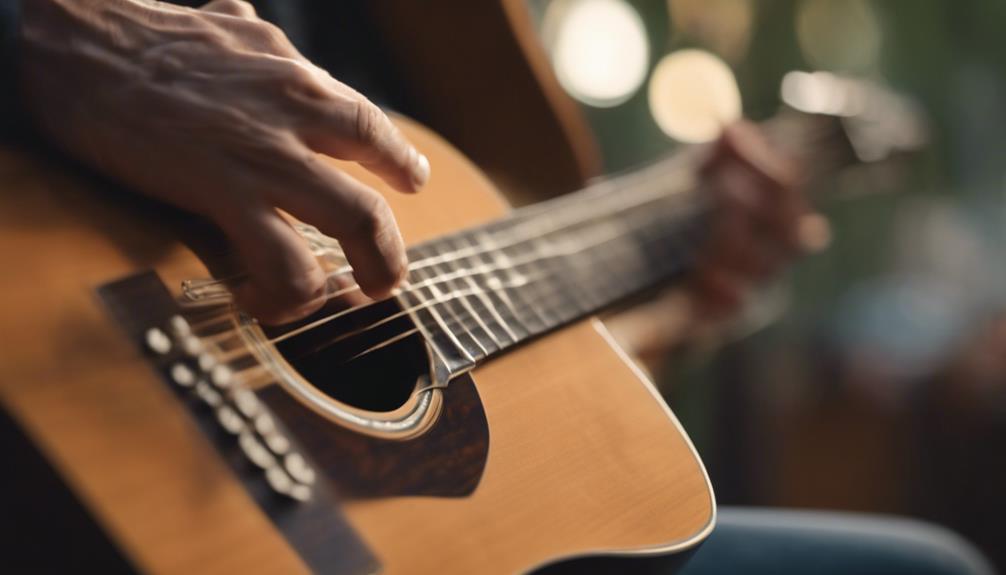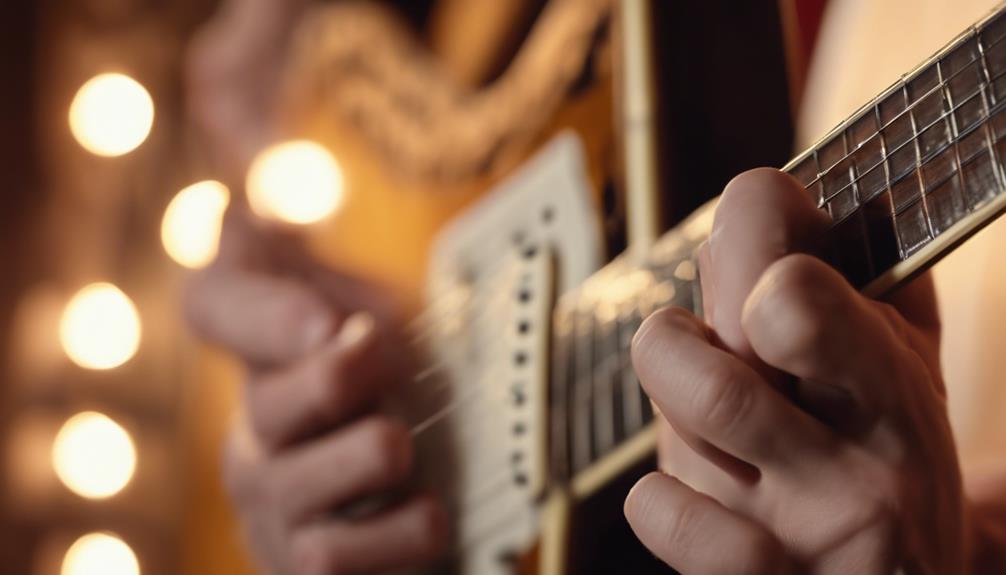When you’re starting to play rhythm guitar, the first step is to find the pulse of the music. This involves feeling the underlying beat that drives a song.
Once you’ve got the pulse, you can begin counting in rhythm and dividing the beat to create interesting patterns. But it doesn’t stop there; mastering open chords and power chords is essential.
You’ll also need to learn damping and muting techniques to guarantee a clean sound. So how do you put all these elements together to create a cohesive rhythm guitar performance?
Let’s explore each step in detail.
TL-DR
- Develop an internal metronome by practicing with a metronome to maintain consistent timing.
- Master downstrokes and upstrokes to build fundamental strumming techniques.
- Learn and practice power and barre chords for versatile chord progressions.
- Practice damping and muting techniques to achieve a clean sound.
- Use online resources and structured lessons, like Fender Play, to improve rhythm guitar skills.
Find the Pulse

To play rhythm guitar effectively, you need to find and feel the pulse of the music. The pulse is the constant beat that flows through a song, acting as your guide to maintain a steady rhythm. By feeling the pulse, you can stay in time and play cohesively with other musicians.
First, listen to the music and identify the beat that repeats consistently. This is your pulse. Once you’ve found it, tap your foot or nod your head to internalize this beat. These physical actions help anchor you to the pulse, making it easier to sync your strumming and chord changes.
When you tap your foot to the pulse, you’re creating a metronome within yourself. This internal metronome is essential for maintaining a steady rhythm. As you practice, you’ll find that staying in time becomes second nature, allowing you to focus more on the nuances of your playing.
Counting in Rhythm
To master rhythm guitar, you need to understand time signatures, especially the common 4/4 time.
Focus on mastering downbeats and upbeats by counting out loud and tapping your foot.
Practicing with a metronome will help you stay consistent and improve your timing.
Understanding Time Signatures
Understanding time signatures is vital because they inform you of how many beats are in each measure and what type of note gets one beat. When you see a time signature like 4/4 at the beginning of a piece of music, it means there are four beats in each measure and each beat is a quarter note.
This is important for counting in rhythm, as it helps you stay on beat and maintain the correct tempo while playing music. Common time signatures you’ll encounter include 4/4 and 3/4. In 3/4, there are three beats per measure, and again, each beat is a quarter note.
Knowing the time signature allows you to understand the structure of the music and ensures that you play in sync with other musicians. Each beat in a time signature corresponds to a specific note value, making it easier to break down and comprehend complex rhythms.
Mastering Downbeats and Upbeats
Ever wondered how to keep your rhythm guitar playing tight and engaging? As a rhythm guitar player, mastering downbeats and upbeats is essential. Downbeats are the strong beats counted as 1, 2, 3, 4 and provide a steady foundation.
Upbeats fall between these, counted as ‘and’ or ‘&,’ injecting dynamic and syncopated energy into your playing.
To maintain a consistent tempo, you’ve got to understand the relationship between downbeats and upbeats. Counting in rhythm helps improve your timing and coordination. Start by tapping your foot on the downbeats while strumming on each beat.
Then, add the upbeats by strumming between the downbeats—1 and 2 and 3 and 4. This practice ensures you’re hitting every beat and maintaining a steady rhythm.
Focusing on downbeats gives your playing a solid base, while upbeats create a lively and engaging groove. By internalizing this pattern, you’ll find your rhythm guitar parts becoming more dynamic and well-executed.
Practicing With Metronome
When you practice with a metronome, you’ll notice a significant improvement in your timing and rhythm skills. Start by setting the metronome to a comfortable tempo, one that allows you to focus on strumming in time with each click. It’s essential to listen closely to the metronome and match your strumming patterns to its steady beat.
As you become more comfortable, gradually increase the tempo. This will challenge your ability to maintain consistency and help you develop better control over your timing and rhythm skills.
Don’t rush this process; it’s important to build a solid foundation at slower tempos before pushing yourself to faster speeds.
Consistent practice with a metronome also helps you internalize the beat, making it easier to keep time without relying on external cues. This skill is invaluable when playing with other musicians or performing live.
Dividing the Beat

Dividing the beat into smaller parts is essential for maintaining consistent rhythm and timing in your guitar playing. When you focus on subdividing the beat, you break the rhythm into more manageable pieces. This helps you keep time accurately and stay in sync with the rest of the music. For example, you can divide the beat into halves, quarters, eighths, or even sixteenths.
By mastering these subdivisions, you enhance your rhythm guitar skills and overall musicality. To get started, use a metronome to practice. Set the metronome to a comfortable tempo and begin by playing along with each click. Once you’re comfortable, start subdividing the beat by playing notes on every other click, then on every click, and finally in between the clicks.
This methodical approach will improve your timing and precision. Remember, consistency is key. By practicing with a metronome regularly, you’ll develop a strong internal sense of timing, making your rhythm guitar playing much tighter and more reliable.
Keep experimenting with different subdivisions to challenge yourself and build your rhythmic versatility.
Open Chords
Next, let’s talk about open chords, which form the basis of many songs.
You’ll learn common open chords like E, C, and G, focusing on proper finger placement to guarantee clear sound.
We’ll also cover basic strumming patterns to help you start playing rhythm guitar effectively.
Common Open Chords
Open chords, like E, C, G, D, Em, and Am, form the backbone of many songs and are essential for any rhythm guitarist. These common open chords are the building blocks of your chord library, giving you the foundation needed to play a variety of music genres.
Each of these chords has its own unique shape and sound, created by combining fretted notes with open strings. This combination results in a rich, resonant tone that’s perfect for rhythm playing.
Mastering these open chords is important because they allow for smooth chord shifts, which are vital when you’re changing chords quickly within a song. For instance, moving from G to C, or from Em to Am, becomes second nature with practice.
These shifts are the glue that holds your rhythm playing together, making your performance sound seamless and professional.
Proper Finger Placement
Proper finger placement is essential for producing clear and strong notes when playing open chords. When you play the guitar, positioning your fingers correctly can make a world of difference in your sound quality.
Here are some key tips to make sure your chords ring out perfectly:
- Position near the frets: Place your fingers close to the frets, but not directly on them. This minimizes the buzzing noise and helps produce clear, strong notes. For example, when playing an open G chord, position your fingers just behind the frets for the best sound.
- Use your fingertips: Press down on the strings using the very tips of your fingers. This ensures that each string rings out clearly without being muted. It’s especially important when playing chords like C or D, where adjacent strings can easily get muted if your fingers aren’t arched properly.
- Keep your wrist relaxed: Maintain a straight and relaxed wrist. This not only prevents strain but also allows for smoother shifts between chords. When you play, a relaxed wrist helps you move fluidly from one chord to the next, enhancing your overall playing experience.
Practicing these finger placement techniques will improve your guitar playing, making your chords sound clean and powerful.
Strumming Patterns Basics
Mastering strumming patterns is essential for creating rhythm and bringing your open chords to life. Open chords, such as E, G, and C, form the backbone of rhythm guitar playing.
To get started, you’ll need to understand the basics of strumming patterns, which involve a mix of downstrokes and upstrokes.
First, hold your pick loosely but securely. Begin with simple downstrokes on each beat to get a feel for the rhythm. Once you’re comfortable, add upstrokes between the downstrokes. For example, try a pattern like DOWN-down-up-UP-down-up. Practice this slowly with your open chords, focusing on maintaining a steady tempo.
Consistency is key. Strum with even pressure and keep your hand moving smoothly. Use a metronome to help with timing and to make sure you’re staying in rhythm. Start slow and gradually increase your speed.
Experiment with different strumming patterns to add variety and dynamics to your playing. Change up the combination of downstrokes and upstrokes to see what feels natural and sounds good with different open chords.
Power Chords

When it comes to playing rhythm guitar, power chords are a fundamental technique that every guitarist should master. These chords are made up of just the root note and the fifth, giving them a strong and full sound that’s perfect for rock, punk, and metal music. Because they use only two or three notes, power chords are relatively simple to play, making them ideal for beginners.
One of the best things about power chords is their versatility. You can move them around the fretboard to play different chords without changing the shape of your fingers. This makes it easier to switch between chords quickly and efficiently, which is essential for maintaining a steady rhythm.
Here’s why you should focus on mastering power chords:
- Simplicity: Power chords are easy to learn and play, even for beginners.
- Versatility: Move them up and down the fretboard without altering the finger shape.
- Sound: They provide a strong and full sound, perfect for many music genres.
Barre Chords
To get started with barre chords, focus on proper finger placement to guarantee clean sound.
Practice common shapes like the F and B minor chords, and experiment with moving them up and down the neck.
Consistent practice techniques will help you build the strength and dexterity needed to master these chords.
Proper Finger Placement
You’ll need to press down multiple strings with your index finger to play barre chords correctly. This finger basically acts as a movable capo, allowing you to form various chords with the same shape.
Here’s how to make sure your finger placement is spot-on:
- Position Your Index Finger: Place your index finger flat across the fretboard, pressing down on all the strings. Make sure it’s close to the fret without touching it to avoid muting any strings.
- Apply Even Pressure: It’s important to press down hard enough so that every string rings out clearly. Uneven pressure can cause muted or buzzing strings, which will affect your playing technique.
- Check Your Strumming Hand: Once your index finger is in place, use your strumming hand to check each string individually. Make certain that each note rings out without any buzzing or muting.
Practicing this technique consistently will improve your overall playing technique. Start slowly and gradually build up speed.
Common Barre Chords
Mastering common barre chords, like the F major and B minor, will greatly enhance your guitar-playing versatility. Barre chords involve using one finger, typically your index, to press down multiple strings across the fretboard. This technique allows you to create movable shapes. For instance, the F major barre chord shape can be shifted up the neck to become a G major, A major, and so on, just by moving your hand up a few frets.
Barre chords provide a fuller sound compared to open chords, making them essential for adding richness to your music. The F major and B minor shapes are particularly useful; the F major is a great starting point for major chords, while the B minor is a cornerstone for minor chords.
Practice Techniques
When practicing barre chords, start by ensuring that your index finger applies even pressure across all the strings. This foundational step is essential for clean, clear sound. Barre chords are vital for playing rhythm guitar as they allow you to play various chords up and down the neck without changing shapes.
Here are three practice techniques to help you master barre chords:
- Finger Strength Exercises: Strengthening your index finger is key. Try pressing down on the strings without playing any chords. Hold the position and gradually increase the duration to build stamina.
- Shape Changes: Practice smoothly changing between different barre chord shapes. Start with simple adjustments, like moving from an E major barre chord to an A major barre chord. Gradually increase the complexity as you become more comfortable.
- Consistent Practice: Incorporate barre chords into your daily routine. Play songs that use barre chords to apply what you’ve learned in a musical context. Consistency will help you internalize these shapes and improve your overall playing rhythm.
Mastering barre chords opens up a wide range of musical possibilities. By focusing on these practice techniques, you’ll enhance your playing rhythm guitar skills and gain the versatility to play in different keys effortlessly.
Strumming Patterns

Strumming patterns are essential for setting the rhythm and feel of any song you’re playing. They dictate the groove and can transform a simple chord progression into something dynamic and engaging.
To start, familiarize yourself with both upstrokes and downstrokes. Downstrokes usually provide a strong, driving force, while upstrokes add a lighter, syncopated touch. Combining these creates various dynamics and textures in your music.
When practicing strumming patterns, use a metronome to maintain precision and timing. Even the simplest patterns can sound off if your timing isn’t spot-on. Start slowly and gradually increase your speed as you become more comfortable.
For example, a basic pattern might involve alternating downstrokes and upstrokes in a steady rhythm. As you gain confidence, you can experiment with more complex patterns that include muted strums or accentuated beats.
Alternate Strumming
Alternate strumming, essential for rhythm guitar, involves switching between downstrokes and upstrokes to create a fluid and dynamic sound. By mastering alternate strumming, you’ll achieve a consistent rhythm and add much-needed dynamics to your playing.
Here’s how you can get started with alternate strumming:
- Practice Alternate Strumming Patterns: Begin by focusing on simple alternate strumming patterns. Start with a downstroke followed by an upstroke and repeat. This will help you improve your timing and coordination.
- Maintain a Steady Pace: Consistency is key for a strong rhythm. Use a metronome to keep a steady pace and ensure your strumming stays even. Gradually increase the speed as you get comfortable.
- Accentuate Certain Beats: To add dynamics, accent certain beats within your strumming pattern. For example, emphasize the downstroke on the first beat and let the upstrokes be softer. This variation creates a more engaging sound.
Experiment with different strumming patterns and speeds to find what works best for you. By practicing these techniques, you’ll enhance your rhythm guitar skills significantly.
Hammer-Ons and Pull-Offs

Hammer-ons and pull-offs are essential techniques that can add depth and expressiveness to your rhythm guitar playing.
Hammer-ons involve playing a note and quickly pressing down on a higher fret to create a smooth shift.
On the other hand, pull-offs are the opposite: you play a note and then pull your finger off to sound a lower note.
These techniques can greatly enhance the dynamics of your playing. By incorporating hammer-ons and pull-offs into your rhythm patterns, you can create a more fluid and expressive sound.
This adds a layer of complexity and interest to your music, making it more engaging for listeners.
When starting out, practice hammer-ons and pull-offs slowly to build coordination and finger strength. Focus on getting a clean and precise sound.
Don’t rush the process; mastering these techniques takes time but will pay off in the long run.
As you become more comfortable, try integrating hammer-ons and pull-offs into your regular playing style.
You’ll notice how they can make your rhythm guitar parts more dynamic and interesting, giving your music a unique and expressive quality.
Damping and Muting
Mastering damping and muting techniques is essential for achieving a clean and controlled rhythm guitar sound. These techniques help you manage unwanted noise and enhance the clarity of your playing.
Damping involves lightly touching the strings with your fretting hand to stop unwanted noise and vibrations. Muting, on the other hand, uses your palm or fingers to control sustain and create percussive effects.
To get started with damping and muting techniques, focus on the following:
- Fretting Hand Damping: Lightly rest your fretting hand fingers on the strings you’re not playing. This stops them from ringing out and adds precision to your rhythm guitar playing.
- Palm Muting: Place the edge of your picking hand’s palm near the bridge of the guitar. This technique is popular in rock and metal genres, creating a tight, punchy sound by reducing sustain.
- Finger Muting: Use your picking hand’s fingers to mute specific strings. This technique is useful when you need to isolate certain strings for a cleaner sound.
Incorporating these damping and muting techniques into your practice routine can greatly improve the overall sound and clarity of your rhythm guitar playing.
Practice With Songs

Having honed your damping and muting techniques, let’s apply these skills by practicing with songs that feature simple chord progressions. Start by choosing songs with basic chord progressions. This will allow you to focus on strumming patterns and improving your timing without getting overwhelmed by complex changes.
Use online resources or apps to find chord charts and play along with the songs. Websites like Ultimate Guitar or apps like GuitarTuna can be incredibly helpful.
As you practice, pay close attention to the shifts between chords. Smooth shifts are key to maintaining a steady rhythm.
Playing along with the original recordings can greatly enhance your sense of timing and coordination. Listen closely to the song and try to match your strumming patterns to the original guitarist’s playing.
This will help you internalize the rhythm and make your playing sound more cohesive.
Rhythm Guitar Examples
Explore iconic rhythm guitar examples from legendary songs to enhance your playing and understand different styles. Start with ‘Smoke on the Water’ by Deep Purple. Its simple, yet powerful riff is a great way to get a feel for rock rhythm guitar. Learn how the repetitive strumming patterns create a solid foundation for the song.
Next, delve into ‘Wonderwall’ by Oasis. This song is perfect for practicing varied strumming patterns and improving your rhythm skills. Pay attention to the nuanced strums and how they drive the song’s progression, giving it that distinct feel.
Finally, study the rhythm guitar parts in ‘Back in Black’ by AC/DC. This classic rock anthem is a masterclass in tight, punchy strumming and rhythmic precision. The chord progressions here are straightforward but incredibly effective at creating an infectious groove.
To make your practice sessions more engaging, here are three essential examples to learn:
- ‘Smoke on the Water’ by Deep Purple – Focus on the iconic riff and rock strumming patterns.
- ‘Wonderwall’ by Oasis – Practice varied strumming patterns to improve rhythm.
- ‘Back in Black’ by AC/DC – Study precise strumming and effective chord progressions.
Next Steps

To enhance your rhythm guitar skills, concentrate on smoothly switching between power chords and experimenting with diverse strumming patterns. This practice will improve your rhythmic precision and make you a good rhythm guitarist.
Incorporate hammer-ons and pull-offs to add dynamics to your rhythm playing, making your sound more engaging and versatile.
Learning to play various strumming techniques, such as alternate strumming, is vital for adding variety. By mastering these techniques, you’ll find your rhythm playing becomes more fluid and interesting.
Don’t hesitate to explore Fender Play’s rhythm guitar lessons; they offer structured learning paths that can help you progress systematically.
While rhythm playing is your focus, don’t ignore the importance of playing lead. Understanding lead guitar concepts can enhance your overall musicianship and improve your rhythm guitar skills. By learning to play both rhythm and lead, you’ll become a more well-rounded guitarist.
Next up, learn how to write a guitar solo in this guide.
